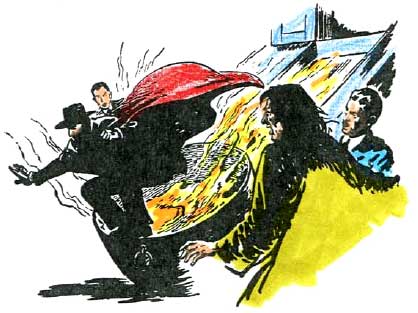|

This story was published in Radio Recall, the journal of the Metropolitan Washington Old-Time Radio Club, published six times per year.
Click here to return to the index of selected articles.
|
|
THE SHADOW
The History and Mystery of the Radio Program: 1930-1954
 BY Martin Grams, Jr. BY Martin Grams, Jr.
OTR Publishing, 2011, 850 pp.
Reviewed by Rob Farr
(From Radio Recall, August 2011)
Martin Grams Jr., one of our most prolific chroniclers of 20th Century broadcasting, has recently published this magnum opus. It is fitting that it takes the better part of 1000 pages to tell The Shadow’s story, since for many people the iconic character is synonymous with the Golden Age of Radio itself. The Shadow’s broadcasting history spans the entirety of the golden era of radio drama, and Grams’ book is an in-depth look every aspect of the program’s and the character’s many incarnations.
Readers of this journal need no introduction to Margo Lane and Lamont Cranston, who “knows what evil lurks in the hearts of men” with his hypnotic ability to “cloud men’s minds”. But it is hard to imagine that anyone picking up Grams’ book will not learn some new and fascinating factoid with each perusal. Even the identity of the first writer of The Shadow stories for Street & Smith Publications began in controversy.
But of course credit belongs to Walter Brown Gibson, who created the character in 1928 and two years later helped launched the radio program on CBS under the title Detective Story Magazine Hour. Gibson devoted his prodigious energies to writing Shadow stories for Detective Story and later, The Shadow Magazine (compilations of which are still in print), but left the scripting and direction of the radio series to other hands.
At first, the Shadow was little more than a spooky narrator. But when Orson Welles came on board in 1937, the sleuth became the central protagonist. Welles is certainly the best-known of the Shadows, but in fact did little more than show up at the studio to read the scripts sight unseen. Welles’ shear talent hid the fact that he was learning The Shadow’s fate right along with the listeners. Future Shadows were Bill Johnstone (1938-1944), John Archer (just the 1944-45 season) and the longest-running Shadow, Bret Morrison (1945-1954). There were many sponsors (including the inevitable “sustaining” near the end), but best-remembered is the D.L. & W. Coal Company, aka Blue Coal.
Grams also looks at the many Shadow tie-ins, such as the Columbia film serial and the Monogram B-features (who other than Grams could dig out the nugget that the first film Shadow, Victory Jory, was young Bret Morrison’s roommate at the Pasadena Playhouse). And he doesn’t neglect the television pilots, even though The Shadow was never to find a slot on prime-time network TV.
The book is divided into a comprehensive history, an episode guide and various appendices, covering such sundry topics as the South American and Australian versions of the show.

A few words about the author: Martin Grams has made a name for himself as a historian who thoroughly researches his subject matter, resulting in books that are destined to become the last word on OTR programs such as The Green Hornet, Cavalcade of America and Suspense, not to mention the TV shows Car 54, Where Are You?
and Alfred Hitchcock Presents. He is also well-known to East Coast Golden Age OTR, movie and TV aficionados as the founder and guiding presence of the Mid-Atlantic Nostalgia Convention held annually in Maryland.
For Shadow and OTR fans, this tome will be one of the two indispensable volumes on the subject. Because it was co-written by Shadow creator Walter Gibson, The Shadow Scrapbook (Harvest/HBJ, 1979) will remain the “bible” for many fans. But for a detailed, accurate, incisive history of The Shadow radio show and movies, it is hard to believe that there will ever be a better source than Martin Grams’ definitive book.

|